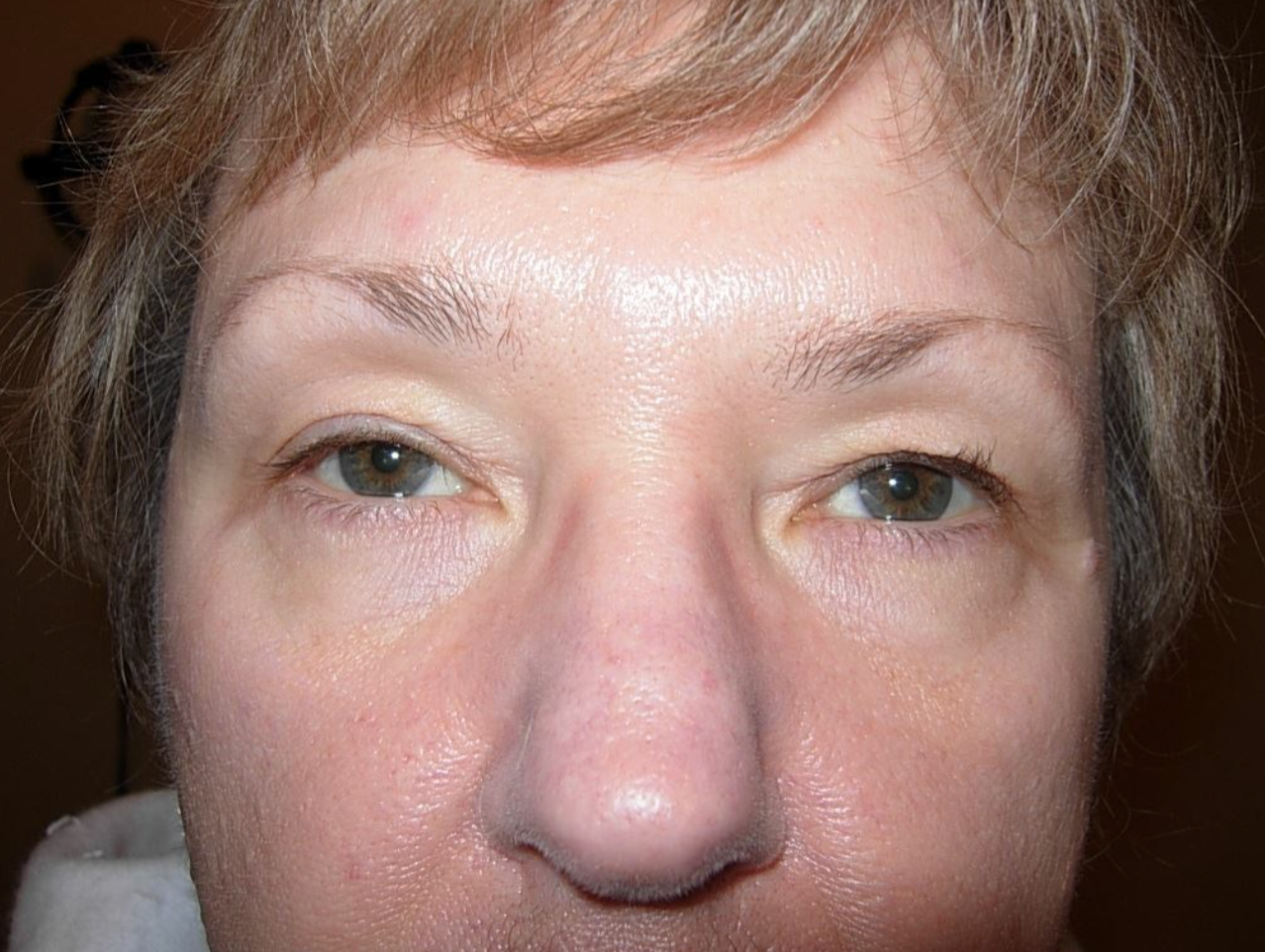 Imagine how it would feel to try to go about your daily routine, only to be stopped in your tracks. Imagine having to work through feelings of weakness - feelings so intense that your own eyelid or eyelids begin to droop, right into your line of vision. Not only are your eyes affected...but it becomes difficult to walk, to stand, to eat, to simply watch TV. And as a result, it becomes difficult to enjoy life itself.
Imagine how it would feel to try to go about your daily routine, only to be stopped in your tracks. Imagine having to work through feelings of weakness - feelings so intense that your own eyelid or eyelids begin to droop, right into your line of vision. Not only are your eyes affected...but it becomes difficult to walk, to stand, to eat, to simply watch TV. And as a result, it becomes difficult to enjoy life itself.
For Marie Yacko, one of Everett and Hurite’s own patients, this scenario doesn’t need to be imagined. These problems plagued her life for more than 17 years. Thankfully, Mrs. Yacko is now managing the illness that created life-altering symptoms. Every day is a blessing to Mrs. Yacko - and every day is a reminder about how her local ophthalmologist team helped her to return to good health with a single diagnosis.
The First Symptom Strikes
What could possibly creating so many problematic symptoms? Mrs. Yacko lives with Myasthenia Gravis: a chronic autoimmune neuromuscular disorder, known for creating inconsistent muscle weakness. Rather than permanently creating feelings of weakness or lethargy, the condition comes and goes, creating temporary but frustrating symptoms.
Prior to her diagnosis and symptoms, Mrs. Yacko’s life was a perfectly normal one. She worked as a transcriptionist at Children's Hospital of Pittsburgh. And during her time there, she learned the names of many diseases. She even heard the name of the illness she herself was living with - long before a diagnosis was given. Unfortunately, she was not that familiar with the disease itself. “If I had been familiar with it, I probably would have known that I had it,” Mrs. Yacko says about her condition.
It was just over 17 years ago that Mrs. Yacko ran into the first of many problematic symptoms. “I started getting ptosis,” she recalls. Ptosis - the drooping of an eyelid - was the most prominent of Mrs. Yacko’s initial symptoms. She also recalls that the symptoms were not subtle in their presentation. They were so impressive that a coworker “would come to my cubicle every morning to see what my eyes were doing [that day].”
Mrs. Yacko quickly went to her doctor to try and get the issue sorted out. Unfortunately, her first visit to a doctor did not reveal any solid results. Neither did a visit to another specialist. And so, “I let it go, and eventually it righted itself. Over the years, I would get it back during stressful times. I just attributed it to stress.”
A Troubling Progression Of Symptoms
For almost seven or eight years, Mrs. Yacko accepted her sporadic symptoms as part of her life. Then, a new symptom developed - and Mrs. Yacko’s life began to seriously dive downhill.
“I started to notice weakness in my legs,” she remembers. “They weren’t always weak, but over the course of the years to now, I lost the ability to do certain things - like stooping down and being able to get back up.”
Mrs. Yacko attributed this symptom to the hip surgery she underwent around the same time. But, as the days turned into weeks, and weeks into months, the problem grew worse - lasting long after she was supposed to have recovered from surgery. The weakness grew so bad, that Mrs. Yacko couldn’t always make it up the steps at night.
Then she eventually collapsed at the top of her steps. Repeatedly.
Fortunately, and incredibly, she never fell down the stairs. But her legs weren’t the only limbs affected. Mrs. Yacko’s arms soon began wobbling when she tried to use her cane - to the point that she didn’t have enough strength to support it. Even eating became difficult as she lost the strength to chew her food.
Through all of this - for nearly two decades! - Mrs. Yacko was working from home, and attempting to live life as normally as possible with her family. She recalls making excuses for her symptoms, and for how she felt. But all along, she knew: something is seriously wrong. The problem was, “I didn’t know who to turn to. I didn’t know who to talk to.”
Then, one day, Mrs. Yacko visited her eye doctor - and everything changed.
A Diagnosis Delivered
When her original doctors found the beginnings of a cataract in her eye back in 2015, Mrs. Yacko was quickly referred to Everett and Hurite for additional treatment. Once there, she initially visited with Dr. Edward Chang - but, when he noticed her drooping eyelid, Dr. Chang recommended that she also meet with Dr. Kent. And so, Mrs. Yacko met with Dr. Charles Kent, first for a consultation, then for a full exam.
It was at that second exam - after proceeding through the normal evaluations - that Dr. Kent mentioned that he had an idea. He asked her to put an ice pack on her eyes. Mrs. Yacko was happy to do so. In fact, she had discovered 8 - 10 years prior that when she put ice on her eyes, it made her feel like she “woke up.” She could see better. And so, she sat with her ice pack, and let Dr. Kent see her “refreshed” eyelid afterward.
 He took one look, and he delivered the diagnosis. Mrs. Yacko had Myasthenia Gravis.
He took one look, and he delivered the diagnosis. Mrs. Yacko had Myasthenia Gravis.
While the diagnosis was a huge step in the right direction, it admittedly was upsetting at first for Mrs. Yacko. “I thought, what kind of a burden am I going to be on my husband now?” she remembers.
Fortunately, it didn’t take long for her to realize that modern medicine would quickly provide more relief than once was possible. Dr. Kent referred her to a neurologist, and one appointment later, Mrs. Yacko had a prescription for medicine that would change her life. Just one day after taking her new medication, “I woke up the next day with more strength in my arms and in my legs than I had had in years. It was my miracle.”
Today, Mrs. Yacko has readjusted to a fairly normal life. Not only are her muscles back to full strength or near full strength - her vision has improved as well, thanks to a small surgical process that Dr. Kent performed only after seeing what Mrs. Yacko’s medicine could, and could not, do for her.
“I feel like he opened up my world,” she says. “My eyelids were like a hood. I couldn’t see above me very well without tilting my head - even when watching TV at night, as I got tired the lid got droopier. Now that I’ve had the surgery, I can watch TV at night.”
It’s not that her condition is cured. Mrs. Yacko periodically experiences bad days. The drooping eye will return. The weakness and shaking in her limbs occasionally strike. But now, she knows, it won’t last forever - and it will remain well-managed for the rest of her life.
From One Patient To Another: Mrs. Yacko’s Advice
Looking back now, Mrs. Yacko is adamant about one thing more than anything else: she should have been more vigilant about her health, and kept regularly visiting an ophthalmologist.
“My vision was always 20/20,” she remembers when asked why she rarely went to an eye doctor even after her eyelid first began drooping. “I didn’t think there was a need.” It was only after her mother developed a degenerative eye disease that Mrs. Yacko began visiting her eye doctor more regularly - allowing them to find the cataract that led to her life changing referral to Everett and Hurite.
Now, Mrs. Yacko has some blunt advice for anyone who wishes to skip an appointment the way she did for so long: it’s foolish, “because you don’t know what’s going on inside of your eyes.”
Her mother didn’t. In fact, her mother avoided reporting her own symptoms for a long time - at which point there wasn’t much they could do about the disease affecting her vision.
“I would tell anyone to go to their eye doctor, to stay on top of their eye health,” Mrs. Yacko says, remembering her mother’s diagnosis - and her own journey back to health. “If I had not had that cataract, I still wouldn’t have an answer.”
Image 1 courtesy of pexels.com.
Image 2 property of Everett and Hurite.
